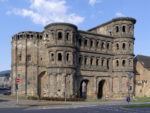 Archaeologists have discovered the precise date of the Porta Nigra, the majestic Roman gate in the ancient city walls of Trier that is the largest ancient city gate north of the Alps. Researchers have determined conclusively that the Porta Nigra was built in 170 A.D. Up until now it was only possible to estimate a date range, a fairly broad one at that of between 150 and 320 A.D. Later modifications obscured the original structure, and while there are date markers on some of the sandstone blocks in the western tower, they are incomplete.
Archaeologists have discovered the precise date of the Porta Nigra, the majestic Roman gate in the ancient city walls of Trier that is the largest ancient city gate north of the Alps. Researchers have determined conclusively that the Porta Nigra was built in 170 A.D. Up until now it was only possible to estimate a date range, a fairly broad one at that of between 150 and 320 A.D. Later modifications obscured the original structure, and while there are date markers on some of the sandstone blocks in the western tower, they are incomplete.
Its massive size also suggested that it was built at least in part to fend off regular attacks from Germanic tribes during the turbulent 3rd century like other large, highly fortified gates from the period. The city walls of Trier (Colonia Augusta Treverorum) were built during the reign of Emperor Marcus Aurelius (161-180 A.D.) which was relatively peaceful. The battles Marcus Aurelius fought against Germanic tribes were east of the Danube. Trier was way west of the hot zone. There wouldn’t have been an obvious need at that point to build a gate with such extensive defensive features. The need, it turns out, was probably the sort of motivation that often underpins monumental construction: to convey the power and prestige of the city.
 It was trees that made this discovery possible, trees, water and the science of dendrochronology (tree ring analysis). In the fall of 2017, archaeologists seeking to answer the question of when the gate was built dug a deep cylindrical shaft at a site adjacent to the Porta Nigra where the ancient walls (demolished by shortsighted wretches after the unification of Germany in 1871) once stood. The site was carefully chosen because the Mosel River flowed through it in Roman times. The team hoped the waterlogged substrate might have preserved timbers used in construction of the gate.
It was trees that made this discovery possible, trees, water and the science of dendrochronology (tree ring analysis). In the fall of 2017, archaeologists seeking to answer the question of when the gate was built dug a deep cylindrical shaft at a site adjacent to the Porta Nigra where the ancient walls (demolished by shortsighted wretches after the unification of Germany in 1871) once stood. The site was carefully chosen because the Mosel River flowed through it in Roman times. The team hoped the waterlogged substrate might have preserved timbers used in construction of the gate.
 At first they came up empty. Then to their jubilation they found two planks and a round piling, but it was a very tempered, serious archaeologically skeptical jubilation because not every piece of wood can be tree-ring dated. In fact it seemed their worry was well justified. The wood looked good from the outside, but were so soft that couldn’t even take the necessary samples. Freezing the pieces helped, making it possible to take a cross-section and get some partial information, but you need more that a piece of a tree to calculate the exact year it was felled. The dendrochronological gods were on their side, however, and the scientists found a small piece of park on one of the timbers that completed the annual tree ring record.
At first they came up empty. Then to their jubilation they found two planks and a round piling, but it was a very tempered, serious archaeologically skeptical jubilation because not every piece of wood can be tree-ring dated. In fact it seemed their worry was well justified. The wood looked good from the outside, but were so soft that couldn’t even take the necessary samples. Freezing the pieces helped, making it possible to take a cross-section and get some partial information, but you need more that a piece of a tree to calculate the exact year it was felled. The dendrochronological gods were on their side, however, and the scientists found a small piece of park on one of the timbers that completed the annual tree ring record.
“This is a milestone in the history of the city of Trier,” said the director of Trier’s Rheinisches Landesmuseum, as the results of the findings were made public on Friday. […]
The fact that the ancient oak wood that was found could be dated to the winter of 169/170 AD was a “stroke of luck,” said Mechthild Neyses-Eiden, an expert in dendrochronology — the science of three-ring dating — who led the research at the Trier museum. At the time, wood was used for construction immediately after being felled, she explained.
Trier was founded by Augustus Caesar in 16 B.C., but very little is known about the first couple of centuries of its existence. (The orgy of destruction after unification didn’t help.) Finally getting a firm date for the Porta Nigra, a UNESCO World Heritage Site and an iconic symbol of the city, helps sharpen an otherwise very hazy picture.

There is still a lot of Roman ‘leftovers’ to be seen in that ‘Colonia’:
When looking at a current plan of ‘Augusta Treverorum’ with the Roman rectangular roads, it becomes obvious that the outer walls (the remaining ‘porta nigra’ is labelled ‘4’) were built slightly later than the town itself.
A Roman land surveyor, therefore, might have used ‘wood piles’ like the one in question here. ..OK, after a 2nd look at it, that ‘pile’ appears now to be massive ‘beam’, and nothing that a surveyor would have messed around with :confused:
It’s worth a visit, Trier. As a preamble to a wine-tasting trip to the Mosel country, obvs.
I had some turnip farming ancestors from that area who later became minor nobility due to the magic of genealogy in the 1930’s. Too bad they didn’t know about that fact back then or they’d have told the Bishop of Trier to dig his own turnips and get out of their house.
I do like the reverence of the guy who is showing off that beam. “It’s the Holy Timber of Trier. Older than the Shroud of Turin, more powerful than the Spear of Longinus, smashing the purported French Prepuce of Christ into jerky! Come one, come all, see the Holy Timber, only ten Euros! Five for the kinder!”
5 for the kinder?
I have often wondered about the word ‘kindling’, but assume that it has a different root, one closer to ‘candle’.
Still, great porta, even with its sometimes dodgy later additions.